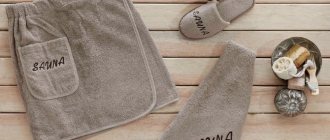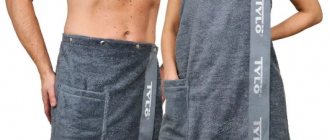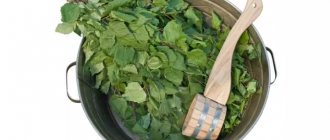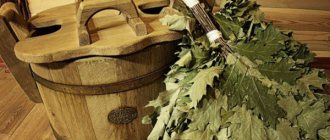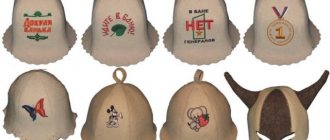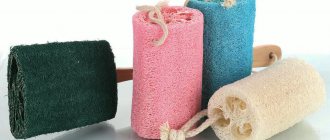A terry turban or turban for drying hair is a very convenient thing after water procedures. How do we usually go? With a huge towel wrapped around your head, very heavy, which also constantly tries to unwind? And our view, well, frankly speaking, is not very good. Let's try to sew a turban for drying hair with our own hands from an ordinary terry towel?
A hand-sewn turban for drying hair from terry cloth is lightweight, dries hair well and does not fall off, as it is securely fixed with a button or elastic band. Yes, and it looks neat and pretty on the head.
The idea of sewing a terry hair turban with your own hands from an ordinary terry towel came to mind when mine, which was once given to me along with a bath set, became worn out, for which I am very grateful to my friends. I really liked the turban for drying my hair; I couldn’t do without it after a shower.
Hair chapma is very convenient not only after a shower or bath, it is for all occasions: when applying masks on the head, instead of an insulating cap, also when applying face masks, so that the hair does not interfere, it is good to tuck it under a turban. But over time, my favorite turban for drying hair became worn out, and at that time I couldn’t find it on sale.
I decided to try to sew a turban for drying my hair with my own hands from terry towels, which are usually plentiful in the household. I figured it out - there doesn’t seem to be anything complicated about it, all you need to do is make one seam.
The hair turban pattern is very simple to make, I did it according to my old one. Although you could search on the Internet, there is now a lot of information on this topic. I have medium-length hair, and my turban for drying my hair fits my size, so I made the pattern based on it. For those who have long hair, it will be enough to simply increase the size of the pattern in length, and if necessary, in width.
I left 1.5 cm for seam allowances. Maybe for some it is not difficult to sew a turban for the head from terry cloth. But for me, sewing a turban from a towel for drying hair is less troublesome, since the border of the towel has already been processed and the entire sewing process will take less time. And old terry towels, which you wouldn’t mind sewing into a turban for drying your hair, will always be available to any housewife.
I overlocked the edges of the product with an overlocker and stitched it on a sewing machine. If you don’t have a machine, it’s easy to sew a turban for drying your hair by hand. You need to overcast the edges of the terry cloth with small stitches, it will take a little longer than using a machine, but it’s worth it. Now you can iron the seams.
All that remains is to sew on the loop and button. A loop can be made from an elastic band and sewn on the narrow end, and a button on the other end of the turban, as shown in the photo. I sewed everything by hand. A turban is put on to dry the hair so that the button is on the back of the head, then the wet hair is wrapped in the turban, twisted on the forehead, and the end is fastened to the button on the back of the head.
Instead of a button with a loop, you can also sew a loop with a hook. You can also sew a rubber loop, stepping back 15-20 cm from the end, then the curled edge of the turban can simply be inserted into the elastic band and the turban will stay well on your head. Well, whoever likes it. My old turban had no loop or button at all, I just wrapped my hair and tied the curled end into a knot.
This is how easy it is to sew a turban for drying your hair with your own hands. By the way, this is a great idea for gifts. I think any woman will be happy with such a gift.
Finally gathered my thoughts to write a review about the towel)
I want to clarify right away that I bought the towel myself. The risk of buying cocoa was minimal, because silk is silk in Africa too! Show me a girl who is indifferent to this material?
A little digression... I, of course, love silk! This love began a long time ago, with my mother’s robe... Then I still didn’t understand silk/non-silk, I just wore it when my mother was not at home. ))) And then, having matured a little, I found out the prices for silk things... I felt sorry for paying almost a month’s salary at that time for a robe, so I sewed it. Yes, the fabric also cost a pretty penny, but still cheaper... Six years ago I read that silk pillowcases are very good for hair and... I also sewed them. A lot of! For some reason it never occurred to me that towels could also be silk.
Going to the brand’s website, I thought that I would limit myself to samples for hair (very interesting samples that seem impossible to sew myself), but, you understand, I also urgently needed a piece of silk for the face.
Silk face towel 32x50 cm color Tea rose from the Silk Manufactory brand
Silk Manufactory is a Russian manufacturer of natural silk products from St. Petersburg. They have certificates of conformity for their activities. The assortment is gorgeous: towels for all parts of the body, bed linen, sleep masks, mittens... And also the most beautiful scarves, stoles and shawls! And, as I understand it, the project includes lingerie. In the manufacture of its products, the brand uses only 100% natural silk of high quality. All products have passed laboratory tests.
Detailed opinion: The half-pot arrived to me very quickly, in proper packaging.
All labels, recommendations, instructions, as expected, were included.
So, why did I decide to splurge a little on a face towel...
Silk proteins have a beneficial effect on the structure of epidermal cells, so a silk towel is necessary to preserve the beauty and youth of facial skin. The hypoallergenic nature of silk allows the towel to be used to care for particularly sensitive skin prone to allergies and irritation. The bactericidal properties of natural silk make a silk towel impeccable in terms of cleanliness and hygiene, even for problem skin.
I tried many different ways of wiping my face after washing... Drying with a terry towel, blotting with disposable paper towels (to me that’s crazy!), not wiping after washing at all (even worse)...
A silk towel allows you to very carefully and gently blot the skin on your face after washing, does not stretch it and does not provoke the appearance of new wrinkles.
We dry our face carefully, apply a towel and press it to our face. We must remember that the subcutaneous layer on the face is very loose and can easily stretch, and therefore vigorous procedures can lead to premature formation of wrinkles.
This towel from the Silk Manufactory is made of two fabrics, which allows you to be doubly gentle on your skin. That is, I simply apply a towel to my face, the first layer of fabric lies motionless, and the second layer can be slightly rubbed over the first, there is no friction on the skin, and the moisture is absorbed instantly.
I can note that after two months of daily use twice a day, after washing and using silk, the skin did not look younger, no, but it became smoother and softer to the touch and visually. Always after a terry towel, my problematic facial skin looked dry and irritated (red), now this is not the case, just a clean, fresh face. It also seemed to me (perhaps it just seemed)) that the pores seemed to narrow after wiping with silk, i.e. I don't see them at all. The relief of the face is even! But, girls, there are a lot of things in my care, maybe a towel has nothing to do with it. However, if you compare the skin after a terry towel and a silk one, the difference is 100% obvious!
It's difficult to describe the sensations, you have to feel it. Naturally, miracles did not happen to my skin, but I want to believe that with such a royal approach to caring for my face, I prolong its youth)))
The towel is made to last, the quality is visible to the naked eye. Everything is hand sewn! All seams are perfectly even.
I want to say that I took a risk once and still washed it in the machine (on the appropriate function, of course) with Planet Organica shampoo (with other silk items), everything went fine, the color did not fade, the seams did not fall apart. From time to time now I don’t shy away from machine washing.
Just yesterday I found another use for it: as a compress. I immerse the towel in a container of warm green tea and apply it to my face several times. The size is perfect for this and the skin underneath is breathable. I like it.
And their trademark quality:
Another undeniable advantage is the lightness and compactness of the product. You can take a towel with you on any trip, it will take up minimal space, and it’s generally ridiculous to talk about weight.
The manufacturer warns: “Caution, silk is addictive!” Absolutely correctly noted!))
I thought it would be a great idea as a gift! Fortunately, the brand has a range to suit every taste and budget. The face towels alone are worth it: with lace, without lace, different colors, different sizes...
Price: 900 rubles Testing period: more than two months Rating: 5+++
To come in
By logging into LiveJournal using a third-party service, you accept the terms of the LiveJournal User Agreement
- Recent Entries
- Archive
- Friends
- Profile
- Memories
LiveInternetLiveInternet
- Registration
- Entrance
—Quote book
- All (1342)
Paper cutouts - dress up games for children Quite recently, I already published paper cutouts.
Magazine on volumetric applique.
gelatin silicone. cheap replacement for liquid silicone
volumetric gold embroidery
—Tags
—Categories
- Lost and Found (1146)
- Video tutorials on needlework (93)
- Felt (22)
- Felting accessories (8)
- Felting toys and other items (6)
- Felting clothes (3)
- Wet felting (6)
- Dry felting (5)
- That's the story! (42)
- Patterns and diagrams (241)
- Embroidery (257)
- Bead embroidery (17)
- Ribbon embroidery (44)
- Embroidered paintings (31)
- Decorative seams (67)
- Needle lace (14)
- Embroidered trim (80)
- Artistic smooth surface (24)
- Knitting (300)
- Knitted clothes (70)
- Crochet (171)
- Knitting on a fork (3)
- Knitting (40)
- Knitted items (35)
- Knitted jewelry (12)
- Irish lace (29)
- Tunisian knitting (5)
- Crochet Lessons (78)
- Freeform (4)
- Decoration and finishing (95)
- Applique (9)
- Paper art (3)
- Decoupage (18)
- Decoupage on fabric (2)
- Activities with children (6)
- Toys (3)
- Textile ideas (195)
- From unread (16)
- Books and magazines (31)
- Cosmetics and beauty (1)
- Aromatherapy (1)
- Cool friends (6)
- Cooking (13)
- Baking (5)
- Snacks and pickles (3)
- Meat dishes (2)
- Master classes (313)
- Fashion (41)
- My Children! (31)
- My Works (54)
- We need to get educated! (395)
- Clothes alterations (12)
- Weaving (13)
- Gifts (27)
- Useful tips (68)
- Clothes care (9)
- Psychology (2)
- Psychotherapy (2)
- Computer work (4)
- Educational textile toys (0)
- Painting (10)
- Fabric painting (4)
- Garden and vegetable garden (8)
- Styles in art and fashion (8)
- Jewelry (70)
- Jewelry made of beads and beads (21)
- Wire jewelry (4)
- Textile jewelry (28)
- Beading (5)
- Plastic jewelry (2)
- Sewing (152)
- Cut (71)
- Patchwork (17)
- Soft toy (13)
- Sewing for dolls (9)
- Sewing clothes (66)
Article on the topic: Why a fence made of corrugated sheets has become banned
—Applications
- All (8)
- Postcards
Reborn catalog of postcards for all occasions - I am a photographer
Plugin for publishing photos in the user's diary. Minimum system requirements: Internet Explorer 6, Fire Fox 1.5, Opera 9.5, Safari 3.1.1 with JavaScript enabled. Maybe it will work - Online game "Big Farm"
Uncle George left you his farm, but, unfortunately, it is not in very good condition. But thanks to your business acumen and the help of neighbors, friends and family, you are able to turn around a failing business. - Wall Wall
: mini-guest book, allows visitors to your diary to leave messages for you. In order for messages to appear on your profile, you need to go to your wall and click the “Update” button - always no analogues at hand
^_^ Allows you to insert a panel with an arbitrary Html code into your profile. You can place banners, counters, etc. there
-News
- All (5)
—Links
- All (236)
-Music
- All (17)
—Photo album
- All (94)
-Video
- All (1)
-Wall
- To the application
—Subscription by e-mail
—Search by diary
—Interests
- All (13)
-Friends
- All (624)
— Regular readers
- All (844)
—Communities
—Broadcasts
-Statistics
Towel selection criteria
When choosing a silk towel for comfortable use, you should pay special attention to the size, composition and density of the product.
Optimal size
The optimal towel size is 65-70 cm wide and 90-100 cm long. These parameters are universal, and the towel can be used not only for hair, but also for the face and body. A towel smaller than 50x70 cm is suitable only for the face and hands; bath towels have a size of 70x140 cm.
Color
Most often, a silk towel is dyed in creamy pink, beige and golden shades. Dyeing is done in 2 ways: dyeing threads or finished fabric. To obtain snow-white fabric, the raw material is treated with a special solution of hydrogen peroxide for 12 hours at a temperature of 70°.
Density
Hair towels are made from crepe linen. Crepe fabric is obtained by twisting the threads in different directions. The thread can be twisted up to 1 thousand times.
Crepe fabric, compared to other types of silk, is characterized by the greatest elasticity, density and wear resistance. It wrinkles less and requires easier maintenance. On average, the density of a towel should be between 19 and 22 mommy, which means the number of threads per 1 mm of fabric.
For more gentle care and better absorbency, it is recommended to use 2-layer towels.
We sew a turban for a bath from a towel.
What is a towel good for?
What is a towel good for?
It's not that we don't know anything about THIS, it's just that you can quickly and easily make small gifts out of towels. Needlewomen from different countries, for example, make them for Christmas, and for home comfort too.
Hair towel
And, really, what could be more convenient right after a bath? But the main thing here is not so much convenience as our neat and even cute appearance
Article on the topic: What is a heat exchanger in a sauna stove
Well, tell me I’m wrong looking at the photo below?
And some ladies complicate the process by duplicating the towel with a lining - but it’s beautiful. Did you notice the button?
Found on sewlikemymom.com
SPA towel for procedures known to us, we also mean procedures at home
from-skiptomylou.org;Found on modaeacessorios-feltromara.blogspot.it;Found on iliketomakestuff.blogspot.com
A towel with a hood for children is a convenient thing
Found on theribbonretreat.com
and this is a pattern for a children's cape with a hood
Found on mydecoupagedlife.com
And another children's model, decorated with fabric trim
Gift towel with applique. And pay attention to the snowflakes made from buttons - that’s how beautiful it can turn out
Found on blog.craftsnthings.com
Another convenient thing - for the kitchen HANGING TOWELS
And for children in the bathroom is also a good idea. And here is a master class for sewing it yourself
Found on vivaveltoro.com
And a variety of kitchen items:
A simple pattern to have a complete understanding of the process
Found on kleiosbelly.wordpress.com
Cute gift ideas, creative dresses with imagination
How to sew a towel dress
Found on treyandlucy.blogspot.com
And if you have buttons lying around somewhere, you can make a towel with buttons by adding a colored insert to the usual waffle one.
Found on simplydiy2.blogspot.com
There is another clever way to trim a kitchen towel with ribbon or braid.
Found on purlbee.com
Well, even in the life of the most ordinary kitchen you can add bright variety if you approach your everyday life creatively. And for gifts, these are definitely cute ideas. You've already noticed the prices of dull potholders in stores. Immodest ambitions for four seams :-))
Happy New Year, girls! Let's be happy!
How does a silk towel affect the condition of curls?
The outer layer of hair, the cuticle, consists of many scales that fit tightly together. The scales serve as protection against the negative influence of external factors. As a result of the tight fit of the scales, the curls acquire a mirror shine.
A towel made of rough material injures the curls, disrupting the tightness of the scales, which begin to bristle. The curls become fluffy, tangled and break off.
A silk hair towel affects the condition of curls as follows:
- a silk towel is an absolutely smooth fabric; sliding over the hair, the fabric does not harm it, does not violate the tightness of its fit, unlike, for example, a terry towel, the loops of which cling to the curls. This property is important for curly, weakened and color-prone hair;
- the material does not accumulate static electricity and does not electrify the hair;
- due to the special weaving of the threads, silk absorbs water well, while the curls remain moisturized, soft and elastic, which is especially important for dry, lifeless, injured hair;
- according to the special hair care method “Curly Girl Method”, silk can be used to break up curls when styling curly hair; The curls are shiny, bouncy and frizz-free.
DIY turban for drying hair from a towel
A terry turban or turban for drying hair is a very convenient thing after water procedures. How do we usually go? With a huge towel wrapped around your head, very heavy, which also constantly tries to unwind? And our view, well, frankly speaking, is not very good. Let's try to sew a turban for drying hair with our own hands from an ordinary terry towel?
Article on the topic: Why fillers are not allowed in the bathhouse
A hand-sewn turban for drying hair from terry cloth is lightweight, dries hair well and does not fall off, as it is securely fixed with a button or elastic band. Yes, and it looks neat and pretty on the head.
The idea of sewing a terry hair turban with your own hands from an ordinary terry towel came to mind when mine, which was once given to me along with a bath set, became worn out, for which I am very grateful to my friends. I really liked the turban for drying my hair; I couldn’t do without it after a shower.
Hair chapma is very convenient not only after a shower or bath, it is for all occasions: when applying masks on the head, instead of an insulating cap, also when applying face masks, so that the hair does not interfere, it is good to tuck it under a turban. But over time, my favorite turban for drying hair became worn out, and at that time I couldn’t find it on sale.
I decided to try to sew a turban for drying my hair with my own hands from terry towels, which are usually plentiful in the household. I figured it out - there doesn’t seem to be anything complicated about it, all you need to do is make one seam.
The hair turban pattern is very simple to make, I did it according to my old one. Although you could search on the Internet, there is now a lot of information on this topic. I have medium-length hair, and my turban for drying my hair fits my size, so I made the pattern based on it. For those who have long hair, it will be enough to simply increase the size of the pattern in length, and if necessary, in width.
I left 1.5 cm for seam allowances. Maybe for some it is not difficult to sew a turban for the head from terry cloth. But for me, sewing a turban from a towel for drying hair is less troublesome, since the border of the towel has already been processed and the entire sewing process will take less time. And old terry towels, which you wouldn’t mind sewing into a turban for drying your hair, will always be available to any housewife.
Article on the topic: How to make a sauna stove with your own hands
I overlocked the edges of the product with an overlocker and stitched it on a sewing machine. If you don’t have a machine, it’s easy to sew a turban for drying your hair by hand. You need to overcast the edges of the terry cloth with small stitches, it will take a little longer than using a machine, but it’s worth it. Now you can iron the seams.
All that remains is to sew on the loop and button. A loop can be made from an elastic band and sewn on the narrow end, and a button on the other end of the turban, as shown in the photo. I sewed everything by hand. A turban is put on to dry the hair so that the button is on the back of the head, then the wet hair is wrapped in the turban, twisted on the forehead, and the end is fastened to the button on the back of the head.
Instead of a button with a loop, you can also sew a loop with a hook. You can also sew a rubber loop, stepping back 15-20 cm from the end, then the curled edge of the turban can simply be inserted into the elastic band and the turban will stay well on your head. Well, whoever likes it. My old turban had no loop or button at all, I just wrapped my hair and tied the curled end into a knot.
This is how easy it is to sew a turban for drying your hair with your own hands. By the way, this is a great idea for gifts. I think any woman will be happy with such a gift.
Unusual options
If you want to look impressive and surprise others with your image, you can tie a turban in one of several unusual ways. These options are more suitable for women.
With tourniquets
One of the most interesting is the option with harnesses. It is these details that require separate consideration. With their help, you can securely fix the turban, and also use it as a decorative option. Here, too, there are a lot of options: you can braid a braid from scarves, make a “basket” or “snail”.
The stole needs to be wrapped around the head several times, tied, and the ends twisted into tight strands. Then they can be folded using one of the above options. It all depends on imagination and desire.
African style
An African turban is very suitable for completing an exotic look. But it should be noted that this option is more suitable for dark-skinned women or those who have a Scandinavian appearance.
The secret of wrapping a stole in this case is as follows: the fabric is wound in numerous layers, and a majestic position of the head is formed in the area of the crown and back of the head.
You can enhance the effect if you use the following tips:
- if you have your own thick and long hair, then you can put it in a bun on the top of your head;
- you need to use a long scarf or 2-3 medium ones;
- make linings that can visually increase the volume.
On the African continent, such a headdress is simply irreplaceable. It not only decorates local women, but also helps them carry weights (jugs of water, food) on their heads.
With a triple knot
You can tie a scarf on your head in the form of a turban using knots. This method is not only relevant, but also very elegant. The step-by-step actions are as follows:
- the scarf needs to be folded diagonally, and then covered with it over the entire head;
- the hanging ends need to be crossed at the back of the head, and then directed upward;
- on the side of them you need to tie three knots in turn.
The remaining ends must be hidden inside to make it neat.
In Turkish
To make a real Turkish turban, it is better to use real Muslim scarves, which have good elasticity. The step-by-step tying scheme is as follows:
- the cloth must be thrown over the head as if it were a hood;
- the free sides cross at the back of the head;
- they throw it upstairs and cross it there again twice;
- the ends are pulled back again and hidden in the interior of the entire structure.
To make the Turkish turban look beautiful and securely fixed on the head, at the final stage the ends of the stole can be additionally tied (before hiding them).
From a square scarf
If you want to make a neat turban, then for this purpose it is better to choose a light square-shaped scarf. You can tie it by following these instructions:
- the scarf must be folded evenly diagonally to form a triangle;
- then it should be placed on the head, but backwards: the long corner should be in front, covering the face;
- the two ends, which should be in the hands at the time of applying the scarf, must be tied into a knot on the frontal part;
- then you need to raise your head, and try to turn the right angle back - thus, at this stage the face should already be open;
- It is recommended to bring the loose ends back and tie them well in a knot.
According to tradition, it is better to hide the ends under a turban.
Friday, December 16, 2016
Turban (turban) for drying hair or going to the bathhouse/sauna. Master Class
- Draw a horizontal line AB 66 cm long at the bottom of your sheet of paper.
- From point B we lay off a segment BC 15 cm long perpendicularly upward.
- Along line AB from point B to the left we lay out a segment BE 30 cm long.
- From point E we lay up perpendicularly a segment ED 24 cm long.
- Connect points A and D with a straight line.
- We divide segment BE into segments 5 cm long, and from each division point we lay perpendiculars upward.
- On the perpendiculars in order, from left to right, we mark segments with lengths of 26 cm, 27.2 cm, 27 cm, 25 cm and 21.5 cm (these are the various numbers I got from my first turban))).
- We connect points D and C with a smooth line along the points marked on the perpendiculars. The pattern is ready.
Article on the topic: What is a wattle fence made of?
——————
*
If you are sewing not from a towel, but from terry cloth (or microfiber fiber - maybe you have something like that on hand)), then you first need to process the edges on which the edge of the pattern will fit with an overlock or zigzag and hem it inside by 0.75-1 cm.
Having tilted the head down, we put on the turban with the wide part back, the narrow part forward, tuck the hair inside, twist the narrow part over the forehead and, bringing it up and back, fasten the button. By the number of turns when twisting, you can adjust the size of the turban and the tightness of its fit on the head.
Male version
An Indian variation of tying a turban, suitable for an adult man or boy.
A scarf is not suitable for these purposes; you will have to purchase a piece of fabric approximately 6 meters long. Its width can be 10-20 centimeters.
- If a man has long hair, it should be tied up in a bun and secured.
- Next, you can put on a special hat (fez, skullcap, patka) or bandana, or you can start wrapping a turban on your bare head.
- After this, the main work begins - the formation of the turban. The selected section must be wrapped diagonally in layers, moving first from right to left, and then vice versa. In this case, you need to make sure that each previous layer “peeks out” from under the next one.
- You can close the crown by releasing one layer of winding from above and distributing it over the head.
- The remaining tip of the cut is tucked under the turban.
What and how to sew a turban, turban with your own hands: ideas, patterns
Famous designers increasingly began to create new and vibrant images, the main focus of which is the turban. After all, such a headdress is a lifesaver if you don’t have time to style your hair or want to add a touch of femininity and sophistication to your look.
And if you don’t want to waste time twisting the structure every time, then you can immediately sew a turban that will not need to be tied. There are several variations, which we will talk about now.
How to use
A silk towel is used as follows:
- The washed hair is carefully wrapped in a towel, without twisting it, and the water is squeezed out with light pressing movements.
- Afterwards, the hair is wiped in the direction of the cuticle scales, from roots to ends.
- You can leave your hair wrapped in a towel for 5-10 minutes. Silk fabric is very light, is not felt on the head, and due to its good breathability, does not create a greenhouse effect harmful to the scalp.
- Then you need to dry the towel and loosen your hair. If the curls are tangled, they need to be carefully sorted out with your hands and dried loose until completely dry.
What fabric can be used to sew a turban?
- Before jumping into the process of sewing a turban, it is important to choose the right material. Most often, Muslim women used silk or brocade, but you can use absolutely any fabric that you like. The only condition is that it must be soft. It can be delicate silk, cashmere or velvet.
- If you are making a turban for the cold season, then give preference to wool blend fabric. But you should not take fabrics that are too rough or thick, otherwise all her femininity and tenderness will be spoiled.
- You should also not choose linen fabric, because... it is too rigid and will form unsightly and rough curves. Felt is also not suitable; at a minimum, the headdress will look ridiculous and cheap.
- And the knitted material is too thin and will stretch out very quickly. Although it is quite often used as an accessible analogue.
- Wool, corduroy or cotton are great because... These materials are quite dense and will hold up well.
- For winter cold, you can even use short-haired fur.
Article on the topic: Is it possible to lay corrugated board along the fence?
With such a headdress you will always be feminine
Why is there a hat in the bathhouse? Features of a bath cap
Many people wear a hat to the bathhouse just for fun, because a person usually looks funny in it. But in reality, a hat is necessary. The steam room has extreme conditions (high temperature and humidity), and the closer to the ceiling, the more aggressive the environment. Staying in a steam room for a long time can lead to overheating, and a person may experience headaches, nausea, or even heatstroke. To avoid overheating and protect your head from high temperatures, bath caps are exactly what you need.
In addition, exposure to high temperatures has a detrimental effect on the condition of the hair. They become overdried, brittle and begin to split. A bath cap will help protect them.
How to sew a turban: a simple way
- You need to take a piece of fabric with a processed bottom edge and bend it in half along its length, so that you get a rectangle of 60 by 30 cm. That is, the initial length of the product should be at least 100 cm. You need to fold the fabric with the right side inward.
Beginning of work
- Now you need to make a slight rounding on the upper right corner.
- Baste the top and side edges and then stitch. Please note that the thread should not be cut. It is also useful for tightening the product to form folds. By the way, it is more convenient to carry out this manipulation directly under the foot of the sewing machine.
- Now, for convenience, pull the hat onto the jar or mannequin, turning it right side out.
Making folds
- Step back literally 3-4 fingers from the intended middle of the headdress (somewhere at a height of 10-12 cm from the edge) and begin to form folds. As you can see in the photo above, the fabric needs to be laid out in a herringbone pattern on top of each other. Go through as many rows as folds will form.
- Their size also plays a role - the larger the grip, the fewer folds will be required. Fasten with thread to secure them.
- Cut off the remaining tail. Just remember to leave 2 cm for processing. This edge needs to be carefully hidden in the folds and hemmed.
Finishing touches
- Next, you need to turn the product back inside out and process the back of the head, carefully assembling it. Adjust seams and gathers if necessary.
Common tying methods
There are many ways to tie a turban: Muslim, with a tourniquet, African and others. They all differ from each other in technique, complexity, and final appearance.
Traditional
The traditional way of winding a turban is also the simplest. To perform it, you need to take a stole (it is better if it has a rectangular shape). Next, you need to place it on the back of your head, and lift the ends up.
The next step is to twist the ends on the frontal part and bring them back again, tie them, and carefully hide the ends.
Most women do approximately this procedure with a towel after washing their hair. It’s just that terry towels look bulky and less elegant.
For long hair
A turban can be beautifully placed on the head, even if a person has long hair. To do this you need to do the following:
- fold the square scarf in half to form a triangle;
- the long sides of this triangle need to be folded overlapping in the direction from the back of the head to the crown - an angle should be formed with the apex in the central part of the forehead;
- then the ends need to be brought back, crossed with tension and returned to the top, tying with a double knot;
- in the end it is better to tuck the edges down.
If you want to remove hair, then you need to use the remaining third corner. The crown can be left open and the hair let out. Any of these options will look beautiful and unusual.
Two-color
To get such a turban, you need to use two scarves of different colors. An important point is that for this purpose it is better to choose scarves made from light fabrics, since otherwise the knots tied will not be so elegant. You need to do the following steps:
- One corner of two selected scarves must be tightly tied together;
- the knot must be attached to the back of the head, and the free corners of the scarves must be taken to the forehead;
- here they need to be crossed and sent back again, and there again crossed and forward;
- tie a knot and hide the ends.
Fashion experts say that this option of wrapping a turban is more suitable for summer.
How to quickly sew a turban?
- This option only requires two sizes and basic sewing skills. Measure the volume of your head - we will take 52 cm as an example. Now you need to measure the length from the depression between the nose and forehead to the 7th vertebra, that is, the bottom of the cervical spine. You need to go with the tape across the forehead, the contour of the head and the back of the head - 47 cm.
Important: You can do it even simpler - take the size from the 7th vertebra to the jugular cavity. When you sew the hat, all that remains is to pull it off at the front and decorate it with a brooch. If necessary, you can slightly adjust the product at the back, creating a small screed.
- If your fabric is too thin, then fold it in half. But in this case, the length of the product must be taken 2 times longer (47*2). Next, as shown in the pattern below, fold the fabric in half widthwise and make a curve from the corner to the middle.
Article on the topic: What to do if you are burned by steam in a bathhouse
Pattern
- Cut it out and stitch along the trimmed perimeter. But we don’t cut the thread, but use it to tighten the segment. Tighten until we get a small hole 1-2 cm in diameter. You won’t be able to turn it inside out, so you sew the stitch as close to the edge as possible. Fasten the corners to make a ring.
Tighten to the desired size
- Cut the jumper in the shape of a rectangle, but round the edges. And also fold the fabric in half, right side inward. Don't stitch through the middle! This hole is necessary to turn the product inside out. Afterwards you can flash it. If the fabric does not fray, then this is not necessary.
- Insert the jumper into the middle of the hole and turn the seam inside out. Hand stitch along the cut edge, securing the jumper itself at the same time. Return to the front side and tie the ribbon beautifully, creating beautiful petals.
You can choose the decoration at your discretion
Note: Using this principle, you can make a turban hat with a rim. To do this, you just need to sew a bandage, which is equal to the circumference of the head, to the assembled base. You can also use contrasting scarves for decoration.
What does the fabric contain?
Silk fiber is formed as a result of the vital activity of the silkworm (caterpillar). On average, 18 kg of cocoons are needed to obtain 1 kg of tissue. The chemical composition of the thread is similar to that of human hair. The thread consists of 97% protein, the remaining part is fatty and waxy components.
The main components of the thread include:
- sericin (up to 40%): a protein characterized by good conditioning, smoothing, anti-aging properties; activates the synthesis of collagen and elastin;
- fibroin (up to 80%): protein that can retain 7 times more moisture; activates the synthesis of collagen and elastin;
- potassium, sodium (up to 2%).
You can experience all the benefits of a silk towel using only fabric consisting exclusively of 100% natural silk. In this case, the label must contain the words “100% Seide”, “100% Silk” or “Organic Seide”.
The last inscription says that the material is environmentally friendly, and the caterpillars were fed with selected foliage, did not resort to the use of hormones, and the mulberries were not treated with pesticides.
Since the cost of natural material is quite high, you can often find products made from synthetic silk, such as acetate, cupro silk (viscose-based), on sale. The external differences of such products are not always noticeable, but the properties of the fabrics are significantly different, and the material will not bring the claimed benefits to the hair.
An elegant option on how to sew a turban
For the pattern, we need the volume of the head, which in our example is 52 cm. The width of the product itself is proposed for consideration at 20 cm, but you can take from this value up to 50 cm. Then there will be more folds, and the headdress will be more voluminous. And one more thing - the length of the product in the example is 70 cm, but the longer the “tails” of the hat, the more turns you will have.
Important: The figure below shows only the pattern diagram. Therefore, take into account the proportions when composing it and do not forget about the smooth rounding.
Note: You can bring out and tie a cute bow in front.
Making a turban with your own hands is quite simple and quick. This product is a must have in every woman's wardrobe. Even if you didn’t have time to do a beautiful hairstyle, then put on an elegant turban in which you will always look elegant and feminine.
Article on the topic: I fly, I fly and why I don’t know, I break fences along the way song
Sizes of scarf for turban
A turban is a rather long piece of material that is wrapped around the head in a certain way. People in eastern countries use scarves for this, the length of which can reach 20 meters. But tying such a scarf will take a long time, and you will need special skill.
If you want to look stylish, then for a turban you can use a scarf measuring 130x40 cm. Sometimes, to create a beautiful turban you will need a longer cloth - up to 2.5 meters in length.
It is not recommended to choose a scarf that is too short for this purpose, since tying it will be quite difficult. And even if you manage to do this, during the process of wearing the turban, the hidden ends may fall out. Ultimately, the entire structure may collapse.
Question: How to create a turban using a towel to dry wet hair?
Microfiber hair towel. How to dress correctly
MICROFIBER towel hat ► MICROFIBER hair towel from Aliexpress.
Video taken from channel: BuyBest
Turban for drying hair
Video taken from channel: Fiodor Copiiov
How to choose a towel for curly hair? How is regular microfiber different from Deva Towel?
Faberlic turban towel for drying hair!
Do-it-yourself turban for drying hair//master class
Video taken from channel: Lyubov Rulevskaya
Sew a turban for wet hair
Video taken from channel: Nina Danilova
No similar articles
How to care for a silk towel
With proper care, a silk towel can last on average from 2 to 5 years.
To preserve delicate and noble fabric in proper quality for as long as possible, the following rules should be observed:
- The product can be washed at a temperature not exceeding 30⁰ or when washing in a washing machine, use the special “Silk” mode;
- Wring out the product and deflate it carefully, without damaging the fabric;
- It is necessary to dry the washed product in a ventilated area and preferably not expose it to sunlight; fabric may change color due to ultraviolet radiation; you should avoid using clothespins, as creases may form;
- when washing your hair daily, you need to wash the towel once a week and it is better to use 2 towels alternately; if you wash your hair more rarely (once every 2-3 days), you can wash the towel once every 2 weeks;
- after use, the towel is dried on a clothes dryer or heated towel rail, after laying a clean, dry cloth, preferably terry cloth;
- ironing of the product is not necessary; you can dry the product on a flat surface; It is allowed to iron the towel with a warm iron or in a specially designed mode.
Enhancing the effect of hair masks using a thermal cap
How to sew a turban on your head from a towel without a pattern
If you want to learn how to quickly and easily sew a turban on your head from a towel, welcome to my master class! It will be a great thing for going to the sauna and bathhouse; you can wrap your head after applying the mask, and just conveniently dry your hair after washing. It is easy to sew, consists of one seam and I don’t need a pattern.
